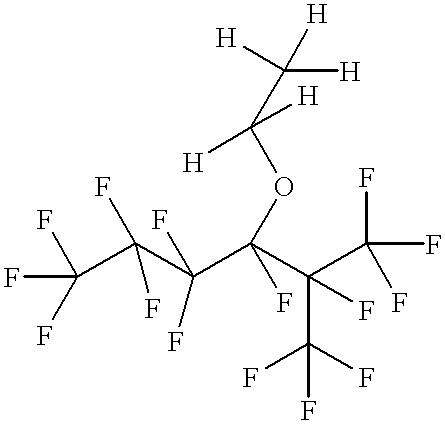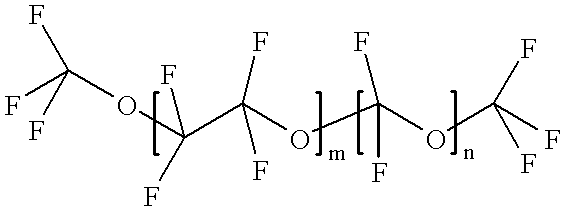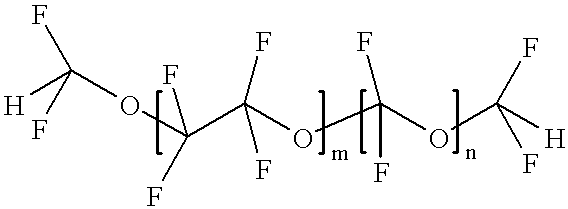Hydrofluoroether as a heat-transfer fluid
- Summary
- Abstract
- Description
- Claims
- Application Information
AI Technical Summary
Benefits of technology
Problems solved by technology
Method used
Image
Examples
example 1
Preparation of n-C.sub.3 F.sub.7 CF(OC.sub.2 H.sub.5)CF(CF.sub.3).sub.2
Into a dry 600 milliliter Parr reactor were added 36.3 grams (0.625 mole) of anhydrous potassium fluoride and 108 grams of anhydrous diglyme (diethylene glycol dimethyl ether). The potassium fluoride was made by spray drying, was stored at 125.degree. C., and was ground shortly before use. The contents in the reactor were cooled with dry ice, then 125 grams (0.52 mole) of n-C.sub.3 F.sub.7 COF (approximately 90 percent purity) were added. When the reactor reached a temperature of 52.degree. C. and pressure of 65 psig (4190 torr), 101.5 grams (0.68 mole) of CF.sub.3 CF.dbd.CF.sub.2 (hexafluoropropylene) were added at 70.degree. C. and at a pressure range of 18-75 psig (1690-4640 torr) over approximately a three hour period, followed by a two hour hold period at 70.degree. C. The reactor and its contents were allowed to cool to room temperature, the reactor was opened, and to the reactor were added an additional 1....
example 2
Experiments were run to verify the pressure drop predictions of the theoretical model detailed above at -40.degree. C. The experimental apparatus is shown schematically in FIG. 4. The apparatus consists of an FTS Model RC-210B-20W chiller 52 connected with insulated polyethylene tubing 54 to a 1.35 meter length of 0.477 cm inner diameter copper tubing which is rolled into a thirty cm diameter coil 56. Holes (0.014 inch (0.0356 cm diameter)) drilled 1.04.+-.0.01 meters apart on the coil serve as static pressure taps. This leaves thirty-one pipe diameters upstream of the inlet static pressure taps and downstream of the outlet static pressure taps. These taps are connected to the ports of an Omega model XPC100DTH differential pressure transducer 58 (0-100 psid, .+-.0.5% of full scale). The mass flow through the coil is modulated with a manually-operated bypass valve 51. A 1 / 16" (0.16 cm) diameter type-J thermocouple 59 is installed in the inlet line just upstream of the coil such that ...
example 3
Freezing or pour points were measured for 3 related hydrofluoroether samples:
(1) n-C.sub.2 F.sub.5 CF(OC.sub.2 H.sub.5)CF(CF.sub.3).sub.2
(2) n-C.sub.3 F.sub.7 CF(OC.sub.2 H.sub.5)CF(CF.sub.3).sub.2
(3) n-C.sub.4 F.sub.9 CF(OC.sub.2 H.sub.5)CF(CF.sub.3).sub.2
The freeze and or pour points were measured by cooling a 1 ml sample contained in a double walled glass tube. The outer tube was sealed at both ends and had side ports for the addition of nitrogen gas. The inner tube was sealed at one end. The annular space between the tubes was purged with dry nitrogen and sealed. The sample was introduced into the inner tube and sealed with a septum. The temperature of the sample contained in the inner tube was monitored with an Omega Model DP-41 (available from Omega Engineering, Inc., Stamford, Conn.) resistance thermal device inserted into the fluid. The apparatus was lowered into the dewar flask of liquid nitrogen.
If the material froze to a white solid, a freezing point is reported. If inste...
PUM
| Property | Measurement | Unit |
|---|---|---|
| Temperature | aaaaa | aaaaa |
| Heat | aaaaa | aaaaa |
| Purity | aaaaa | aaaaa |
Abstract
Description
Claims
Application Information
 Login to View More
Login to View More - R&D
- Intellectual Property
- Life Sciences
- Materials
- Tech Scout
- Unparalleled Data Quality
- Higher Quality Content
- 60% Fewer Hallucinations
Browse by: Latest US Patents, China's latest patents, Technical Efficacy Thesaurus, Application Domain, Technology Topic, Popular Technical Reports.
© 2025 PatSnap. All rights reserved.Legal|Privacy policy|Modern Slavery Act Transparency Statement|Sitemap|About US| Contact US: help@patsnap.com



